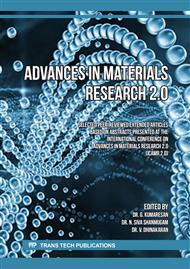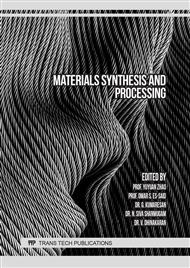[1]
Kuznetsov, V. E., Solonin, A. N., Urzhumtsev, O. D., Schilling, R., & Tavitov, A. G. (2018). Strength of PLA components fabricated with fused deposition technology using a desktop 3D printer as a function of geometrical parameters of the process. Polymers, 10(3), 313.
DOI: 10.3390/polym10030313
Google Scholar
[2]
Raj, S. A., Muthukumaran, E., & Jayakrishna, K. (2018). A case study of 3D printed PLA and its mechanical properties. Materials Today: Proceedings, 5(5), 11219-11226.
DOI: 10.1016/j.matpr.2018.01.146
Google Scholar
[3]
Lanzotti, A., Martorelli, M., Maietta, S., Gerbino, S., Penta, F., & Gloria, A. (2019). A comparison between mechanical properties of specimens 3D printed with virgin and recycled PLA. Procedia Cirp, 79, 143-146.
DOI: 10.1016/j.procir.2019.02.030
Google Scholar
[4]
Porter, J.H., Cain, T.M., Fox, S.L. and Harvey, P.S., 2019. Influence of infill properties on flexural rigidity of 3D-printed structural members. Virtual and physical prototyping, 14(2), pp.148-159.
DOI: 10.1080/17452759.2018.1537064
Google Scholar
[5]
Sarvestani, H. Y., Akbarzadeh, A. H., Mirbolghasemi, A., & Hermenean, K. (2018). 3D printed meta-sandwich structures: Failure mechanism, energy absorption and multi-hit capability. Materials & Design, 160, 179-193.
DOI: 10.1016/j.matdes.2018.08.061
Google Scholar
[6]
Araújo, H., Leite, M., Ribeiro, A. R., Deus, A. M., Reis, L., & Vaz, M. F. (2019). The effect of geometry on the flexural properties of cellular core structures. Proceedings of the Institution of Mechanical Engineers, Part L: Journal of Materials: Design and Applications, 233(3), 338-347.
DOI: 10.1177/1464420718805511
Google Scholar
[7]
Brischetto, S., & Torre, R. (2020). Honeycomb Sandwich Specimens Made of PLA and Produced Via 3D FDM Printing Process: An Experimental Study. Journal of Aircraft and Spacecraft Technology, 4, 54-69.
DOI: 10.3844/jastsp.2020.54.69
Google Scholar
[8]
Zhu, Z. H., Zhang, N., Zhang, Y., Hao, M. Y., & Wu, H. W. (2020). Study of the addition of the hybrid sisal fibers on the dynamic mechanical property of SFs reinforced polylactic acid (PLA) composites. In IOP Conference Series: Materials Science and Engineering (Vol. 744, No. 1, p.012012). IOP Publishing.
DOI: 10.1088/1757-899x/744/1/012012
Google Scholar
[9]
Brischetto, S., Ferro, C. G., Torre, R., & Maggiore, P. (2018). 3D FDM production and mechanical behavior of polymeric sandwich specimens embedding classical and honeycomb cores. Curved and Layered Structures, 5(1), 80-94.
DOI: 10.1515/cls-2018-0007
Google Scholar
[10]
Takayama, T., Daigaku, Y., Ito, H., & Takamori, H. (2014). Mechanical properties of bio-absorbable PLA/PGA fiber-reinforced composites. Journal of Mechanical Science and Technology, 28(10), 4151-4154.
DOI: 10.1007/s12206-014-0927-3
Google Scholar
[11]
Mamun, A. A., & Bledzki, A. K. (2013). Micro fibre reinforced PLA and PP composites: Enzyme modification, mechanical and thermal properties. Composites Science and Technology, 78, 10-17.
DOI: 10.1016/j.compscitech.2013.01.013
Google Scholar
[12]
Setiadi, A., Raharjo, W.W., & Triyono, T. (2017, January). The effect of core thickness variation of sandwich composite cantala rHDPE on mechanical strength of bending test. In AIP Conference Proceedings (Vol. 1788, No. 1, p.030058). AIP Publishing LLC.
DOI: 10.1063/1.4968311
Google Scholar
[13]
Ilyas, R. A., Sapuan, S. M., Harussani, M. M., Hakimi, M. Y. A. Y., Haziq, M. Z. M., Atikah, M. S. N., ... & Asrofi, M. (2021). Polylactic Acid (PLA) Biocomposite: Processing, Additive Manufacturing and Advanced Applications. Polymers, 13(8), 1326.
DOI: 10.3390/polym13081326
Google Scholar
[14]
ASTM, I. (2007). Standard test methods for flexural properties of unreinforced and reinforced plastics and electrical insulating materials. ASTM D790-07.
DOI: 10.1520/d0790-15e01
Google Scholar
[15]
Rajpurohit, S.R., & Dave, H. K. (2018). Flexural strength of fused filament fabricated (FFF) PLA parts on an open-source 3D printer. Advances in Manufacturing, 6(4), 430-441.
DOI: 10.1007/s40436-018-0237-6
Google Scholar
[16]
Kabir, S.F., Mathur, K. and Seyam, A.F.M., 2021. Impact resistance and failure mechanism of 3D printed continuous fiber-reinforced cellular composites. The Journal of The Textile Institute, 112(5), pp.752-766.
DOI: 10.1080/00405000.2020.1778223
Google Scholar
[17]
Sugiyama, K., Matsuzaki, R., Ueda, M., Todoroki, A., & Hirano, Y. (2018). 3D printing of composite sandwich structures using continuous carbon fiber and fiber tension. Composites Part A: Applied Science and Manufacturing, 113, 114-121.
DOI: 10.1016/j.compositesa.2018.07.029
Google Scholar
[18]
Naveed, N., 2021. Investigate the effects of process parameters on material properties and microstructural changes of 3D-printed specimens using fused deposition modelling (FDM). Materials Technology, 36(5), pp.317-330.
DOI: 10.1080/10667857.2020.1758475
Google Scholar
[19]
Kumar, S., Singh, R., Singh, T. P., & Batish, A. (2020). On flexural and pull out properties of 3D printed PLA based hybrid composite matrix. Materials Research Express, 7(1), 015330.
DOI: 10.1088/2053-1591/ab66f4
Google Scholar
[20]
Sanivada, U. K., Mármol, G., Brito, F. P., & Fangueiro, R. (2020). PLA composites reinforced with flax and jute fibers—A review of recent trends, processing parameters and mechanical properties. Polymers, 12(10), 2373.
DOI: 10.3390/polym12102373
Google Scholar
[21]
Pérez‐Fonseca, A. A., Robledo‐Ortíz, J. R., González‐Núñez, R., & Rodrigue, D. (2016). Effect of thermal annealing on the mechanical and thermal properties of polylactic acid–cellulosic fiber biocomposites. Journal of Applied Polymer Science, 133(31).
DOI: 10.1002/app.43750
Google Scholar
[22]
Harper, L. T., Ahmed, I., Felfel, R. M., & Qian, C. (2012). Finite element modelling of the flexural performance of resorbable phosphate glass fibre reinforced PLA composite bone plates. journal of the mechanical behavior of biomedical materials, 15, 13-23.
DOI: 10.1016/j.jmbbm.2012.07.002
Google Scholar
[23]
Islam, M. S., Hasbullah, N. A. B., Hasan, M., Talib, Z. A., Jawaid, M., & Haafiz, M. M. (2015). Physical, mechanical and biodegradable properties of kenaf/coir hybrid fiber reinforced polymer nanocomposites. Materials Today Communications, 4, 69-76.
DOI: 10.1016/j.mtcomm.2015.05.001
Google Scholar
[24]
Eng, C. C., Ibrahim, N. A., Zainuddin, N., Ariffin, H., Yunus, W. M., Wan, Z., & Then, Y. Y. (2014). Enhancement of mechanical and dynamic mechanical properties of hydrophilic nanoclay reinforced polylactic acid/polycaprolactone/oil palm mesocarp fiber hybrid composites. International Journal of Polymer Science, (2014).
DOI: 10.1155/2014/715801
Google Scholar
[25]
Awal, A., Rana, M., & Sain, M. (2015). Thermorheological and mechanical properties of cellulose reinforced PLA bio-composites. Mechanics of Materials, 80, 87-95.
DOI: 10.1016/j.mechmat.2014.09.009
Google Scholar
[26]
Camargo, J. C., Machado, Á. R., Almeida, E. C., & Sousa, S. E. F. M. (2019). Mechanical properties of PLA-graphene filament for FDM 3D printing. The International Journal of Advanced Manufacturing Technology, 103(5-8), 2423-2443.
DOI: 10.1007/s00170-019-03532-5
Google Scholar
[27]
Sbardella, F., Martinelli, A., Di Lisio, V., Bavasso, I., Russo, P., Tirillò, J., & Sarasini, F. (2021). Surface Modification of Basalt Fibres with ZnO Nanorods and Its Effect on Thermal and Mechanical Properties of PLA-Based Composites. Biomolecules, 11(2), 200.
DOI: 10.3390/biom11020200
Google Scholar
[28]
Chow, W. S., & Lok, S. K. (2008). Effect of EPM-g-MAH on the flexural and morphological properties of poly (lactic acid)/organo-montmorillonite nanocomposites. Journal of Thermoplastic Composite Materials, 21(3), 265-277.
DOI: 10.1177/0892705708089477
Google Scholar
[29]
Takayama, T., Uchiumi, K., Ito, H., Kawai, T., & Todo, M. (2013). Particle size distribution effects on physical properties of injection molded HA/PLA composites. Advanced Composite Materials, 22(5), 327-337.
DOI: 10.1080/09243046.2013.820123
Google Scholar
[30]
Ali, W., Mehboob, A., Han, M. G., & Chang, S. H. (2019). Effect of fluoride coating on degradation behaviour of unidirectional Mg/PLA biodegradable composite for load-bearing bone implant application. Composites Part A: Applied Science and Manufacturing, 124, 105464.
DOI: 10.1016/j.compositesa.2019.05.032
Google Scholar
[31]
Gunasekaran, K. N., Aravinth, V., Kumaran, C. M., Madhankumar, K., & Kumar, S. P. (2021). Investigation of mechanical properties of PLA printed materials under varying infill density. Materials Today: Proceedings, 45, 1849-1856.
DOI: 10.1016/j.matpr.2020.09.041
Google Scholar
[32]
Jo, M. Y., Ryu, Y. J., Ko, J. H., & Yoon, J. S. (2012). Effects of compatibilizers on the mechanical properties of ABS/PLA composites. Journal of Applied Polymer Science, 125(S2), E231-E238.
DOI: 10.1002/app.36732
Google Scholar
[33]
Tarrés, Q., Oliver-Ortega, H., Espinach, F. X., Mutjé, P., Delgado-Aguilar, M., & Méndez, J. A. (2019). Determination of mean intrinsic flexural strength and coupling factor of natural fiber reinforcement in polylactic acid biocomposites. Polymers, 11(11), 1736.
DOI: 10.3390/polym11111736
Google Scholar
[34]
Awal, A., Rana, M., & Sain, M. (2015). Thermorheological and mechanical properties of cellulose reinforced PLA bio-composites. Mechanics of Materials, 80, 87-95.
DOI: 10.1016/j.mechmat.2014.09.009
Google Scholar
[35]
Chaitanya, S., & Singh, I. (2018). Ecofriendly treatment of aloe vera fibers for PLA based green composites. International Journal of Precision Engineering and Manufacturing-Green Technology, 5(1), 143-150.
DOI: 10.1007/s40684-018-0015-8
Google Scholar
[36]
Balakrishnan, H., Hassan, A., & Wahit, M. U. (2010). Mechanical, thermal, and morphological properties of polylactic acid/linear low density polyethylene blends. Journal of Elastomers & Plastics, 42(3), 223-239.
DOI: 10.1177/0095244310362403
Google Scholar
[37]
Asumani, O. M. L., Reid, R. G., & Paskaramoorthy, R. (2012). The effects of alkali–silane treatment on the tensile and flexural properties of short fibre non-woven kenaf reinforced polypropylene composites. Composites Part A: Applied Science and Manufacturing, 43(9), 1431-1440.
DOI: 10.1016/j.compositesa.2012.04.007
Google Scholar
[38]
Dong, Y., Ghataura, A., Takagi, H., Haroosh, H. J., Nakagaito, A. N., & Lau, K. T. (2014). Polylactic acid (PLA) biocomposites reinforced with coir fibres: Evaluation of mechanical performance and multifunctional properties. Composites Part A: Applied Science and Manufacturing, 63, 76-84.
DOI: 10.1016/j.compositesa.2014.04.003
Google Scholar
[39]
Valvez, S., Santos, P., Parente, J. M., Silva, M. P., & Reis, P. N. B. (2020). 3D printed continuous carbon fiber reinforced PLA composites: A short review. Procedia Structural Integrity, 25, 394-399.
DOI: 10.1016/j.prostr.2020.04.056
Google Scholar
[40]
Maqsood, N., & Rimašauskas, M. (2021). Characterization of carbon fiber reinforced PLA composites manufactured by fused deposition modeling. Composites Part C: Open Access, 4, 100112.
DOI: 10.1016/j.jcomc.2021.100112
Google Scholar



